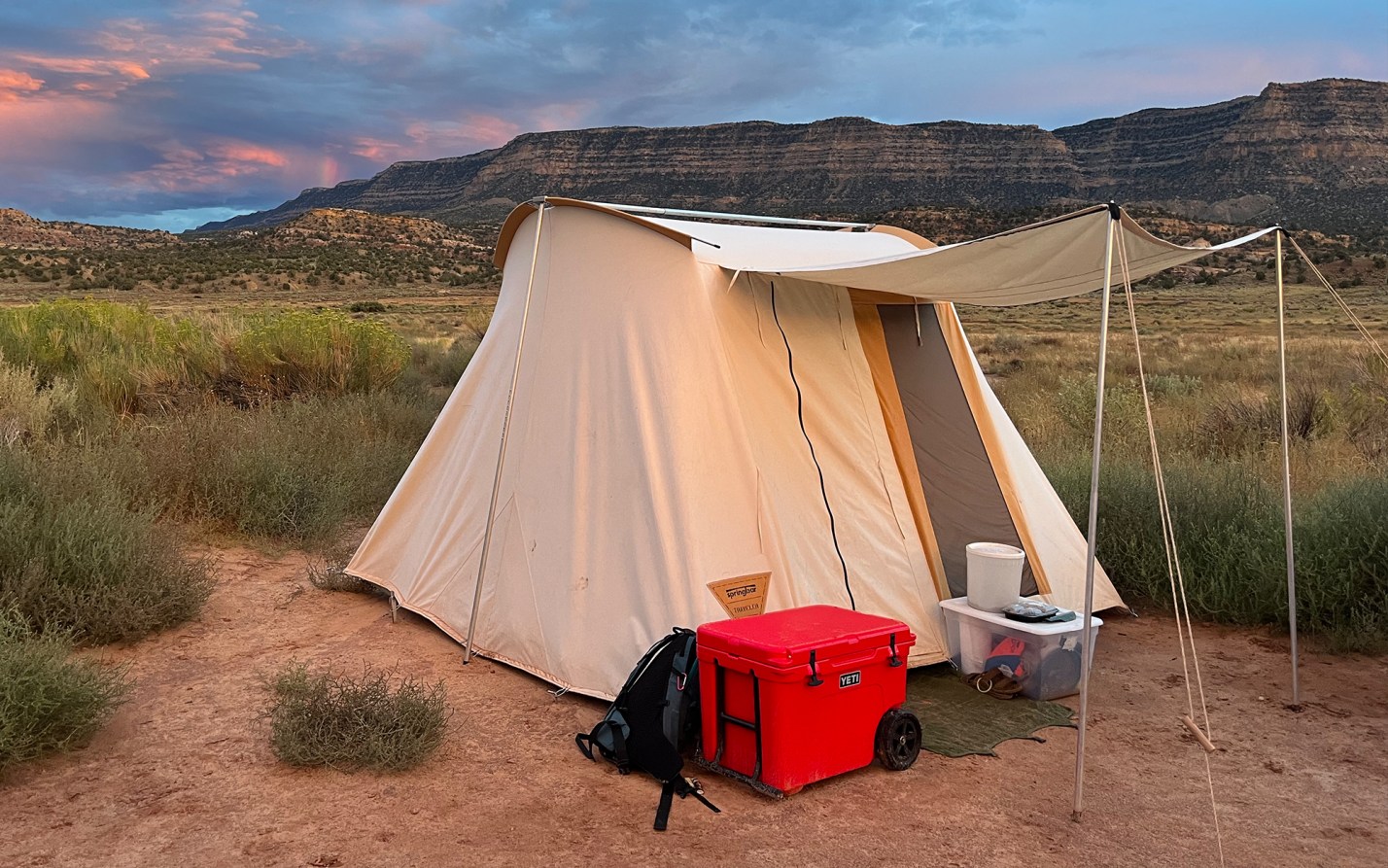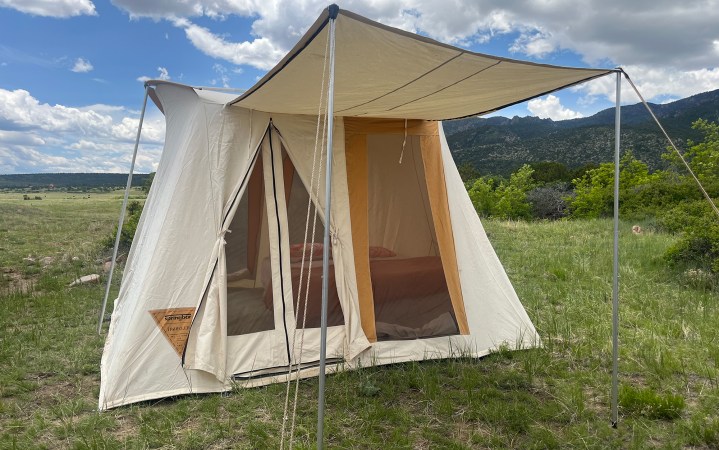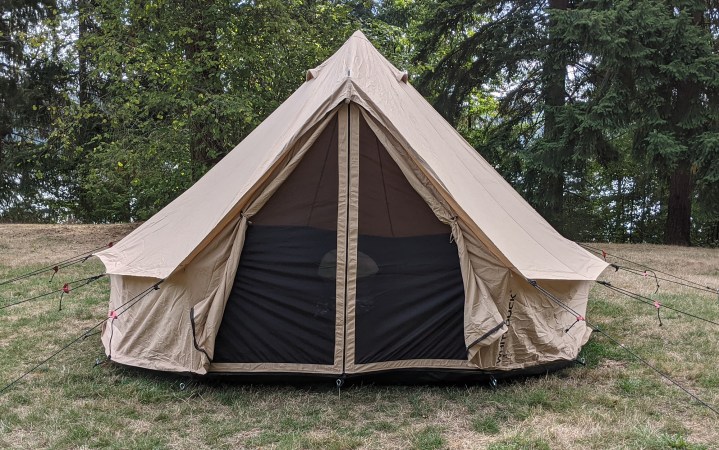We may earn revenue from the products available on this page and participate in affiliate programs. Learn More ›
Canvas tents have fallen out of style with the rise of lighter, cheaper materials. Nowadays, you might only use a canvas tent if you’re glamping, visiting a yurt, or at a semi-permanent hunt camp. But there is a camp that thinks the best canvas tents can be more comfortable, spacious, and sustainable than synthetic tents and still simple to assemble. We put two different styles to the test.
How We Tested the Best Canvas Tents
When the Outdoor Life gear team decided to take on the physically large project of erecting and testing canvas tents, I had no idea the pool of canvas tent manufacturers would be so small. OL staff writer Laura Lancaster and I each tested a canvas tent to get an idea for the experience, as neither of us had actually used one before. To be honest, we were less than enthused with the assignment. After all, there’s a reason no one uses these anymore, right?
But then I discovered Springbar, a Utah company that has been working with canvas in the beehive state since 1944. They invented, and have been manufacturing the revolutionary Springbar tent design since 1961. And it has changed the way I camp forever. So far I’ve taken it out in deserts and forests experiencing rain, hail, high winds, and high heat. Lancaster tested a Regatta Bell Tent in the PNW made by White Duck. It’s a newer company passionate about keeping the sustainability, durability, and comfort of canvas tents alive. So, clearly, canvas tents are not a thing of the past. But do they still hold up for modern weekend warriors?
Best Canvas Tents: Reviews & Recommendations
Springbar Traveler
Key Features
- Materials: 100 percent cotton canvas
- Footprint: 10 x 10 feet
- Interior Height: 6.5 feet
- Packed Tent Size: 21 x 15 inches
- Packed Pole Size: 56 x 8 inches
- Tent Body: 42 pounds
- Pole Set: 22 pounds
- Stakes: 8 pounds
- Non-freestanding
- Price: $1,299
Pros
- Watertight
- Breathable
- Insanely durable
- No-see-um window mesh
- Made in the USA
- Waterproof floor
- One-person setup
Cons
- Heavy
- Takes a little elbow grease to put up
- Must be put away dry
Just as we finished erecting the tent, all seven of us piled in. The rain started to pour and the packed desert dirt immediately began to flood, waterfalls cascading down nearby sandstone. Parts of the floor started to trap small puddles underneath like tiny waterbeds. And the wind picked up menacingly; my friend turned to me and asked, “Are you sure this’ll hold?”
“I’d trust this tent with my life,” I said.
The last car camping tent you’ll ever buy: the Springbar Traveler. In our short four months together, this tent has withstood, rather, thrived in high desert winds, monsoons, hail, and scorching heat. The 10 by 10 footprint isn’t overly large, and the tight design takes advantage of every foot. It’s 6.5 feet tall wherever you stand. It’s extravagant for two, comfortable for four, and fits six. Though more can easily wait out a storm. My friends and I have taken to calling it the slumber party tent.
Weather Resistant
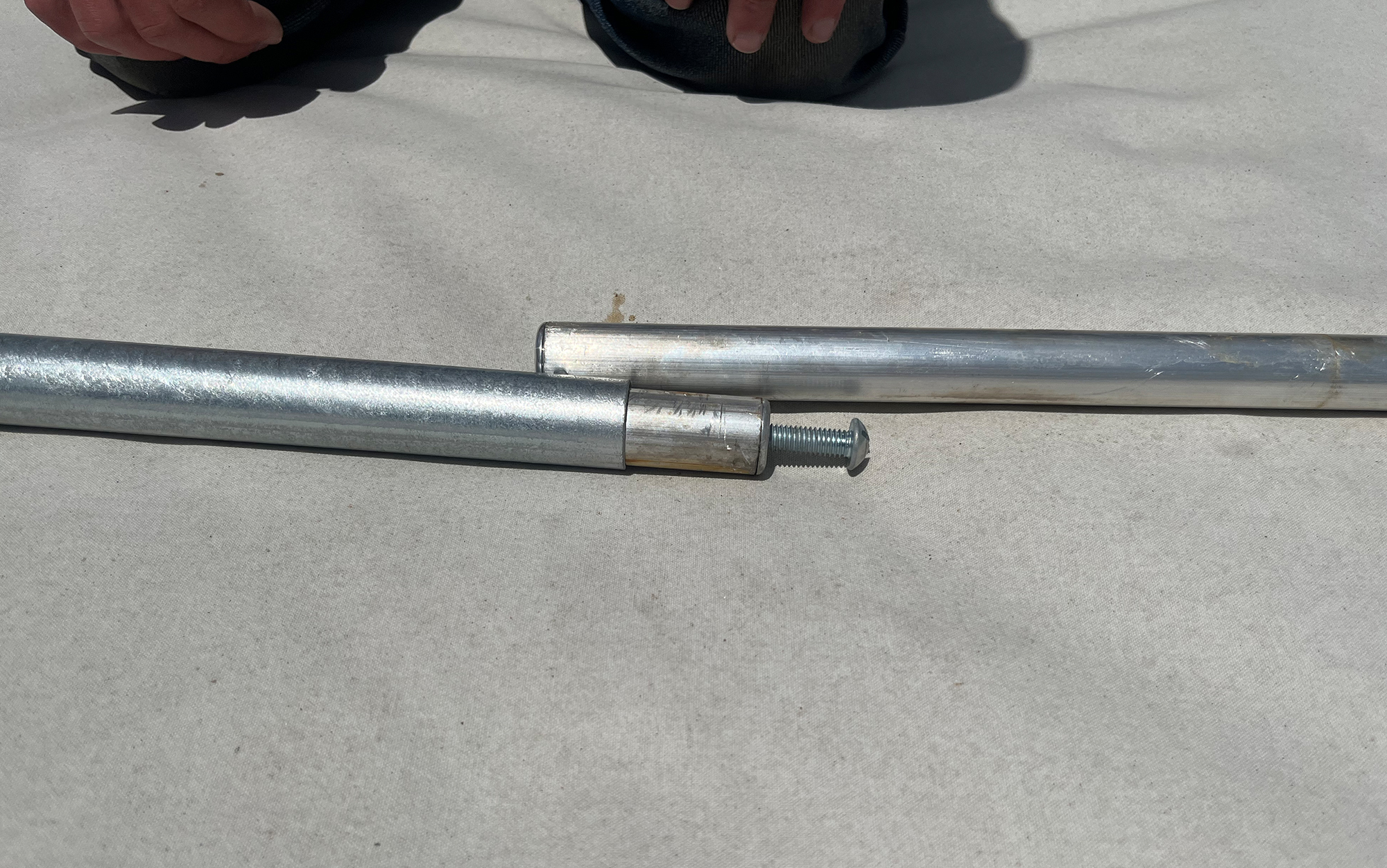
Despite the cutesy nickname we gave it, this tent is bombproof. Springbar tents are designed for high winds. It starts with 12-inch galvanized steel wedge stakes made in Missouri. They’re secured to the tent with steel wire stake loops fixed to a rope lining the perimeter. The rope not only reinforces the attachment points, but also distributes the weight. The frame operates with tension and flex using a spring system. The aluminum poles’ interior is reinforced with steel. They fix into spring steel tension rods to solidify the tent frame. Made in Salt Lake City, Utah, these poles are corrosion resistant and the aluminum lightens the overall weight.
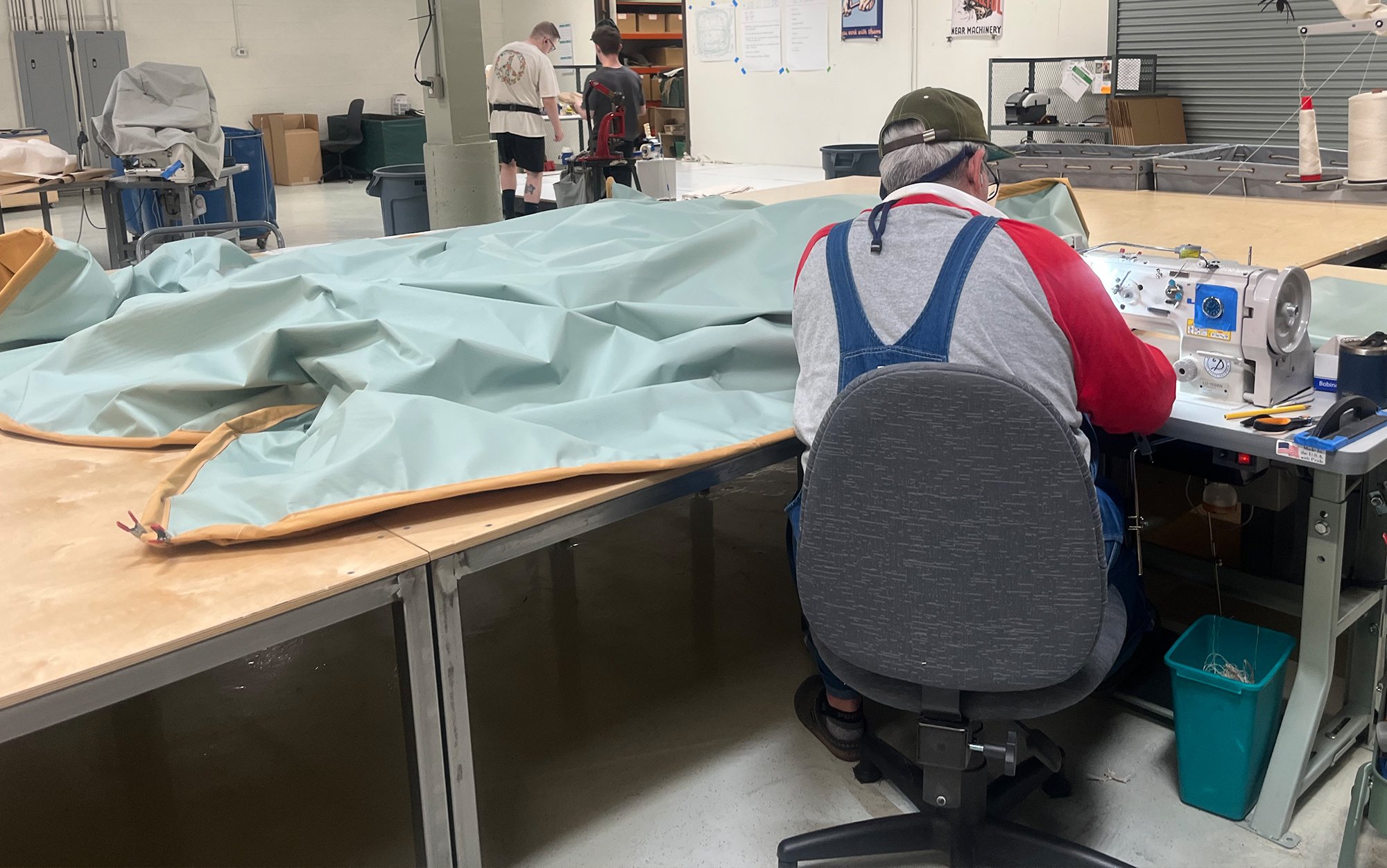
While the seamless vinyl floor is completely waterproof, Springbar tents aren’t. They’re watertight. And while that sounds like a recipe for disaster, it’s where the real magic of this tent begins. Instead of the suffocating bright colored nylon you’re used to, the 100 percent cotton canvas breathes. The Sunforger (gold-standard weather finish) treated cotton shrinks when wet and the tiny holes and seams tighten, keeping water out.
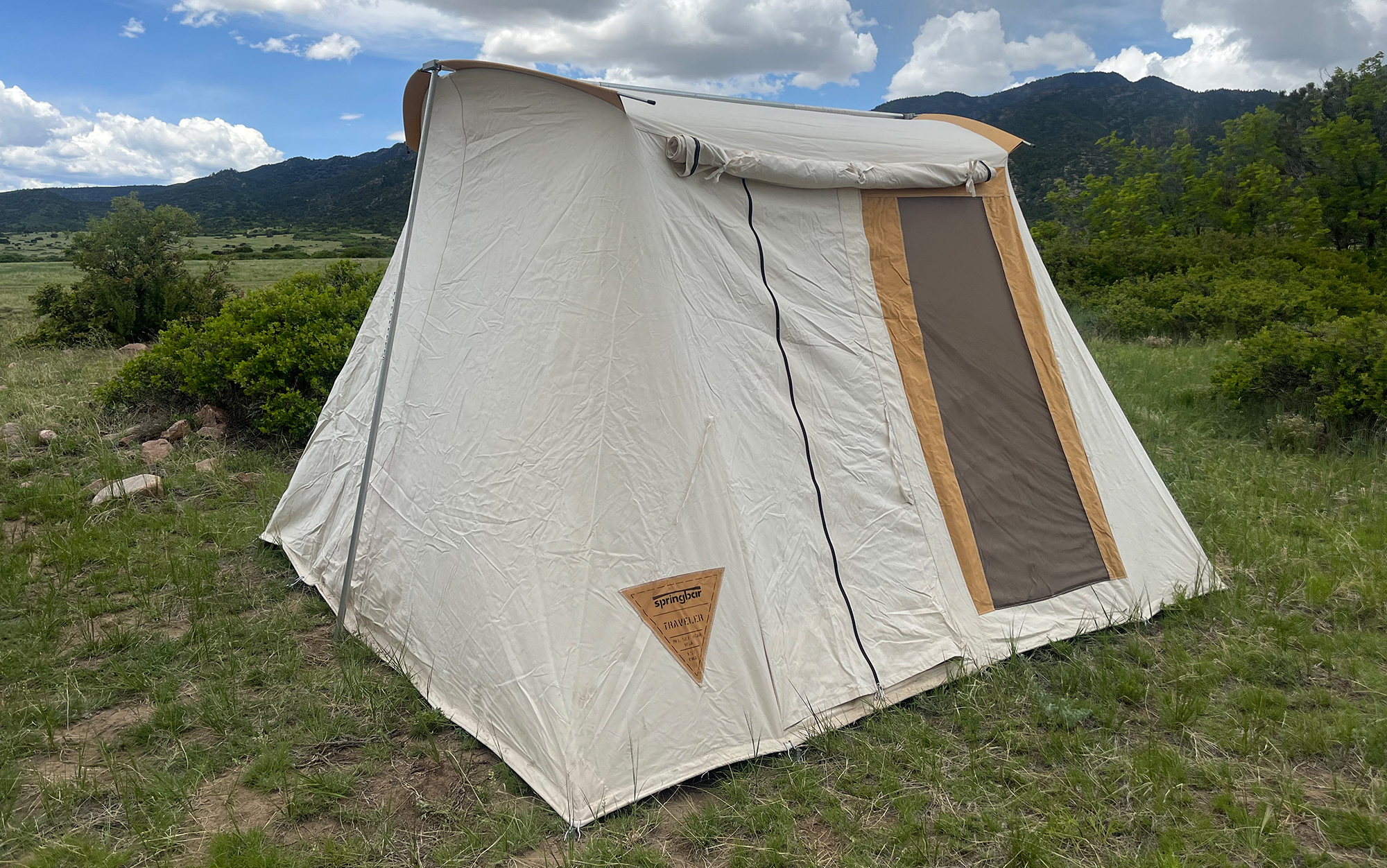
Even the three different threads used in Springbar tents are specially selected and sewn to constrict and swell with the fabric. When dry, the cotton naturally expands to create a more breathable shelter in hot weather. The three full-length no-see-um mesh windows and door don’t hurt either. In cold weather, it’s harder for heat to escape. Springbar tents are warmer in winter and cooler in the summer. It’s by far the most comfortable tent I’ve ever slept in.
Assembly
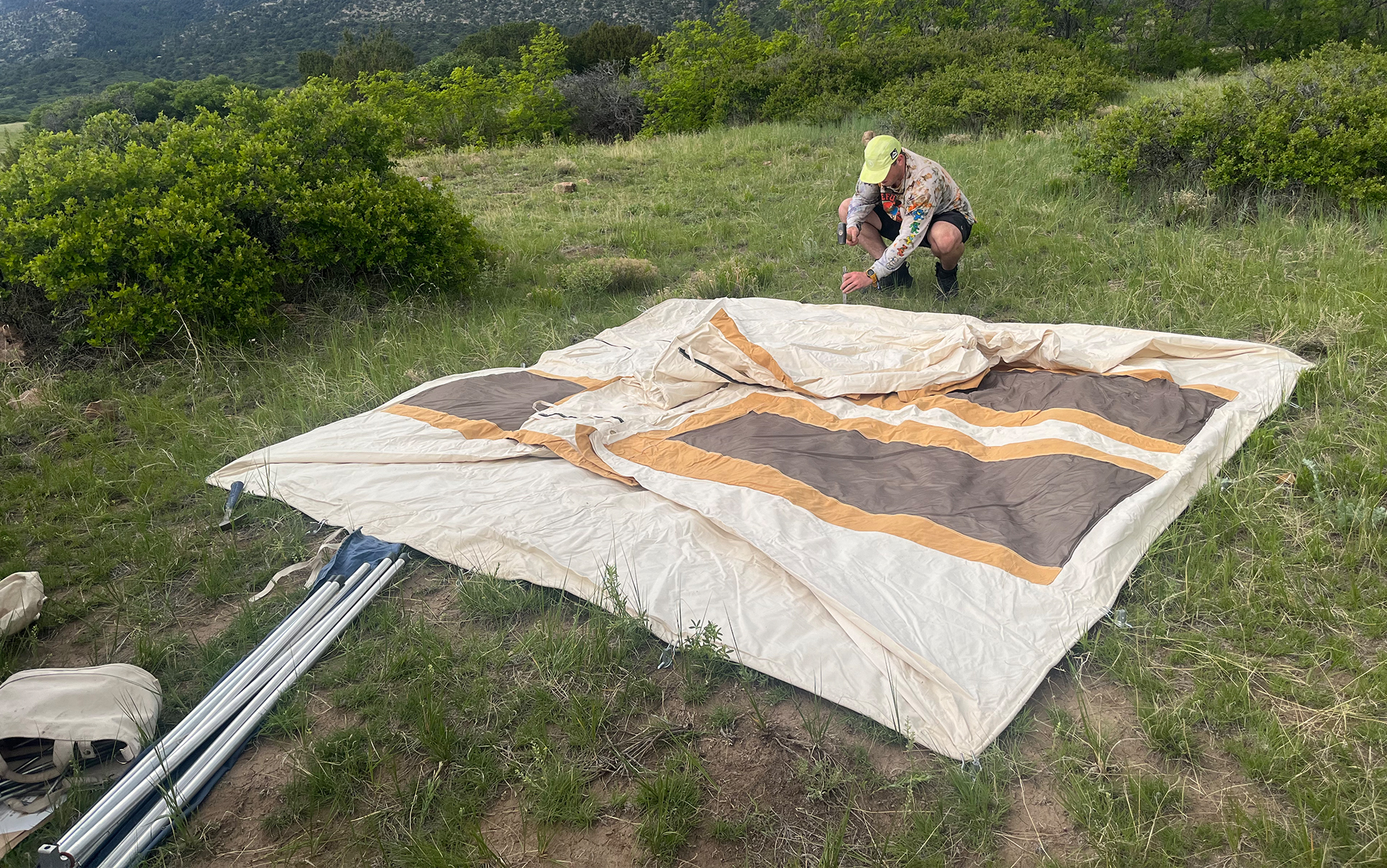
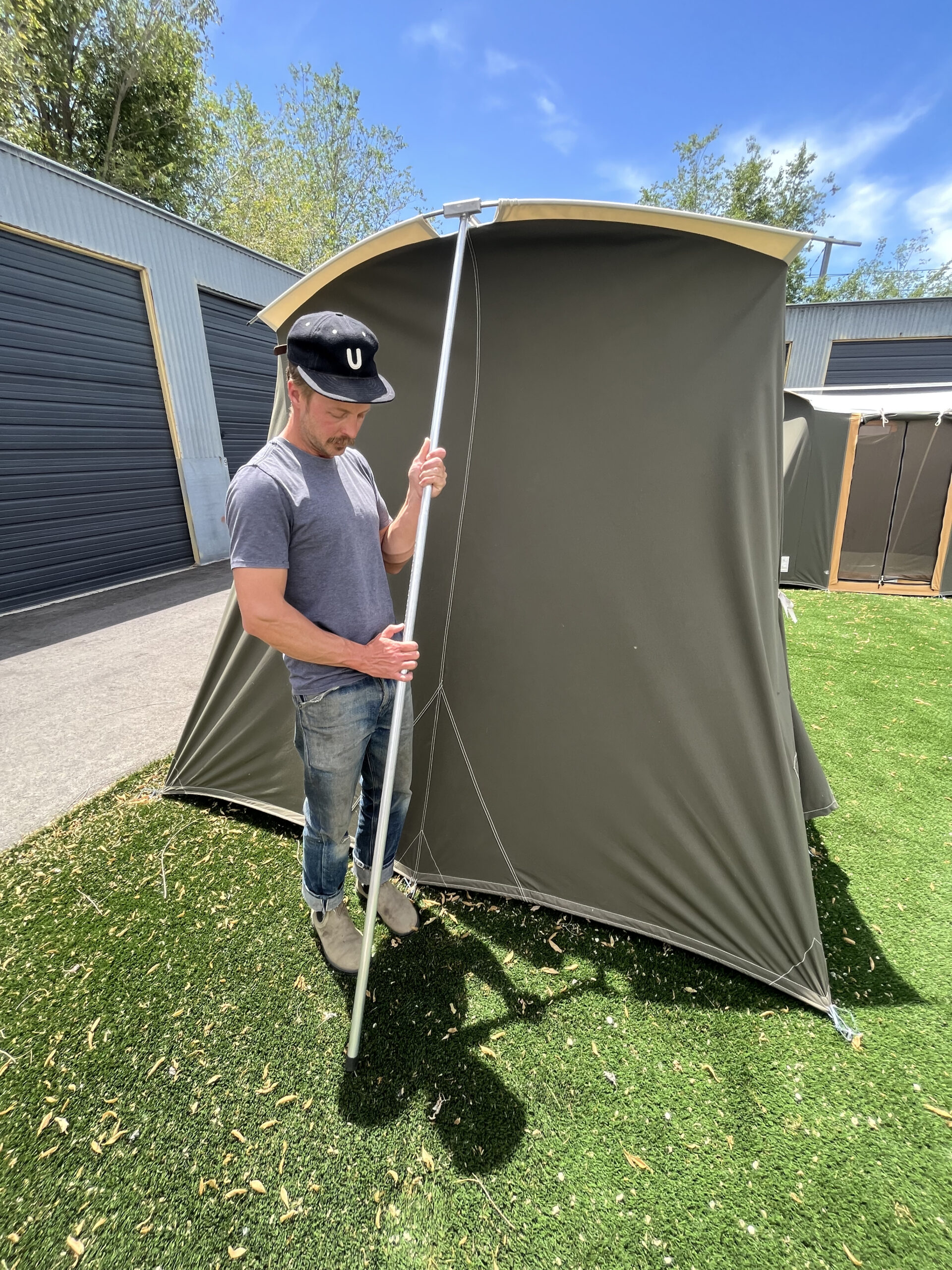
Now, you might be thinking that it takes blood, sweat, and tears to erect this bombproof tent, but you’d be wrong. I’m a 5-foot-7 female and I’ve done it by myself. The most time consuming part is hammering in the stakes, but it goes a lot faster with even one more person. Once you lodge all 20 stakes into the ground with a hammer or mallet, you’re basically done. Sure there are a couple more steps, but the hard part is over. Springbar has an excellent video showing how to put it up solo. Pro tip: Pre-align your upright poles so that you can lift directly up, instead of spinning the pole around to find the holes and lifting at the same time.

Durability
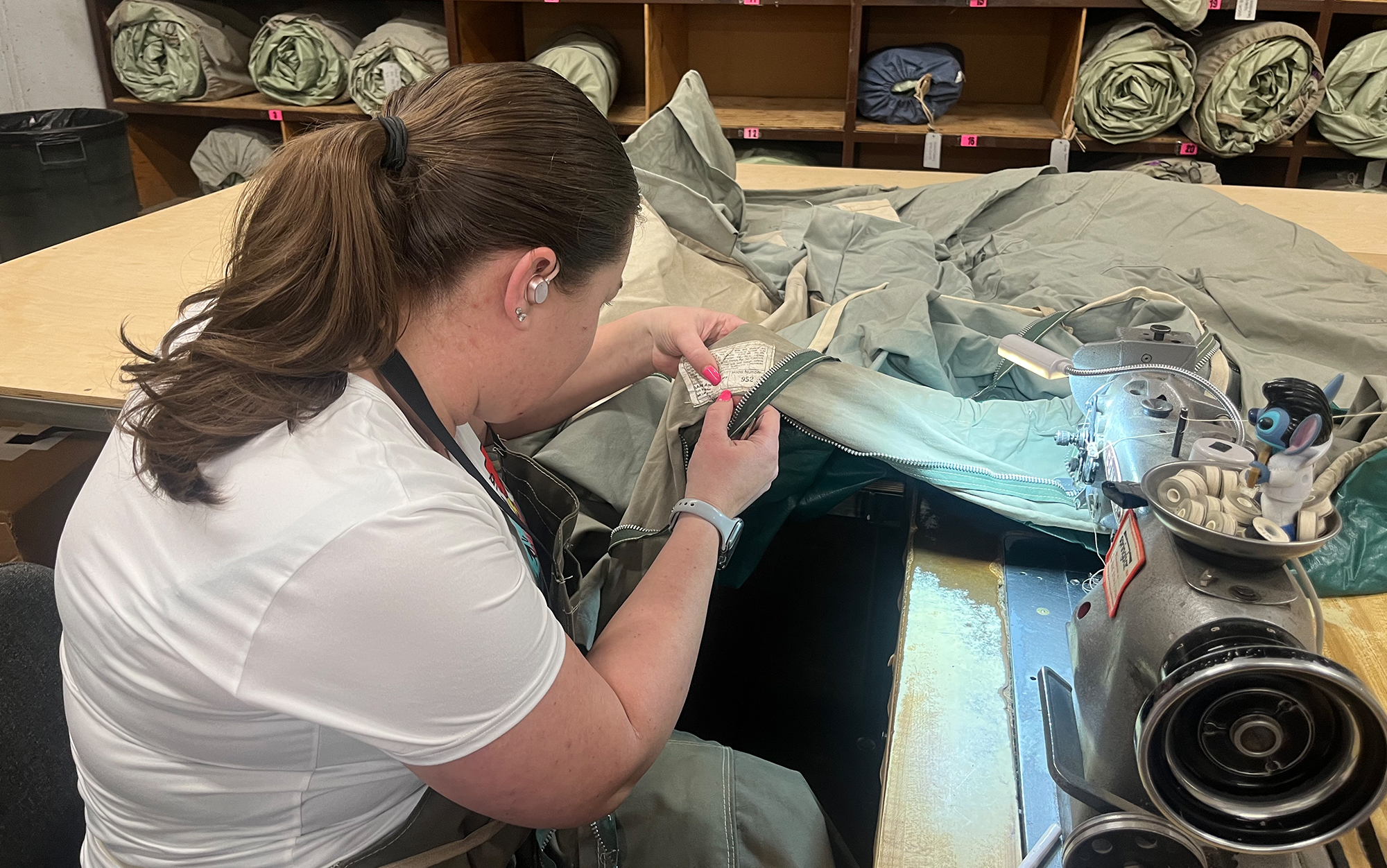
The legendary weather-resistance and Goldilocks size aren’t the only things that make the Springbar tent special. You’re stuck with it for the rest of your life. When I toured their facility here in Salt Lake City, Utah, their repairs specialist was working on a tent from the 1970s. All it needed? some new mesh. With proper care, these tents can last decades and in some cases, generations. If you do need a repair, Springbar does it all in-house at their Salt Lake City sew shop.
This tent’s only kryptonite is mold. Under no circumstances should you store this tent wet. If you’re forced to pack up camp while it’s wet, let it dry when you get home. Mold will cause irreparable damage. But, the weather treatment is mold-resistant and Springbar hasn’t found any issues storing the tent in humid areas like the Northwest or Southeast as long as you store the tent in a dry place.
Testing the Springbar in the Field
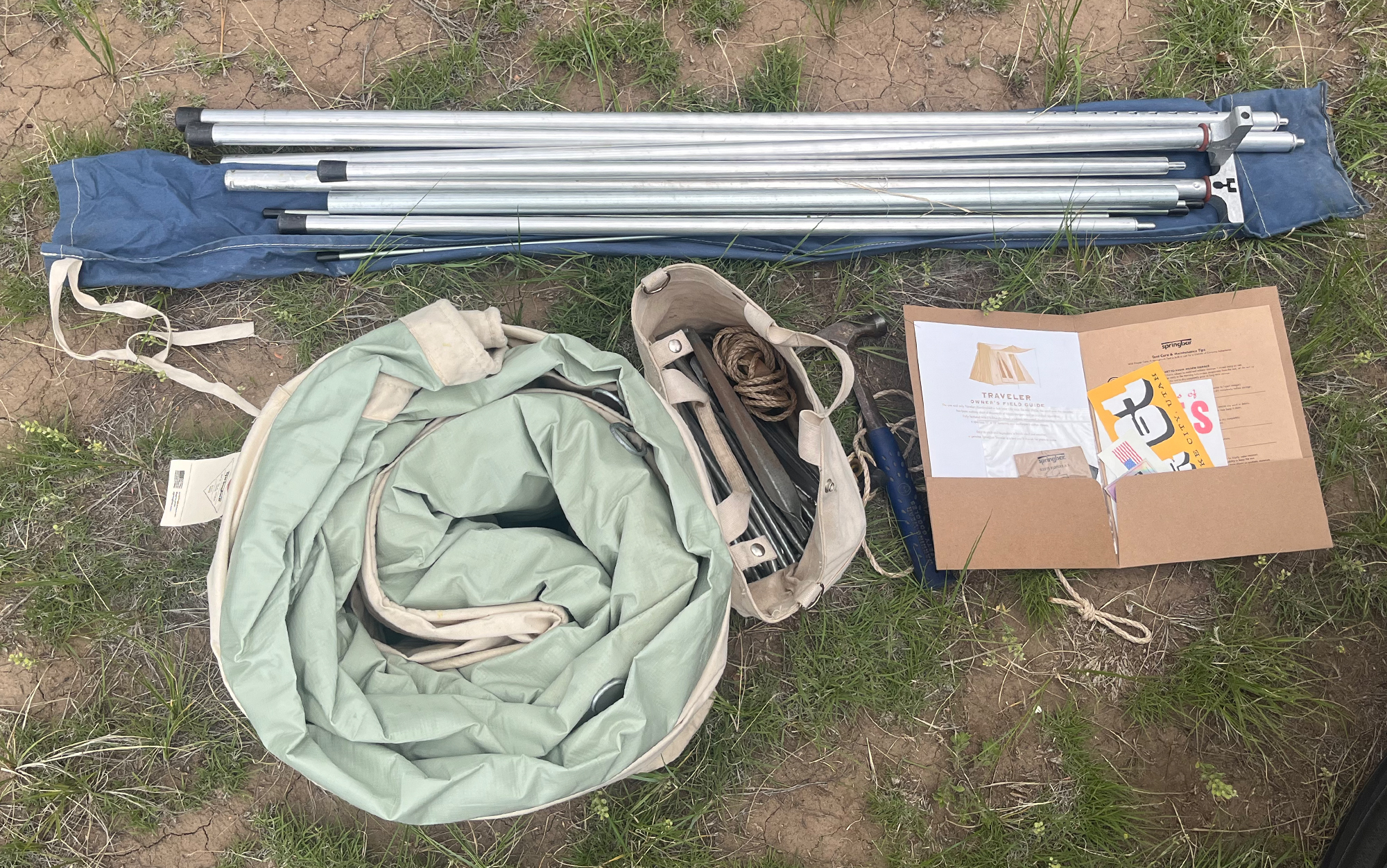
The packed size of the body of this tent is 21 by 15 inches. You also have to bring the 56 by 8-inch bag of poles, but hey, at least they’re skinny. Compare that to the winner of the Best 6 Person Tents test: the Nemo Aurora Highrise 6P Tent at 26 by 9.5 and it isn’t so bad. It’s a little bulky, but to me the space is absolutely justified for the comfort I get once it’s set up at camp. As I said, hammering the stakes takes the most effort, but they are crucial to the structural integrity of the tent.
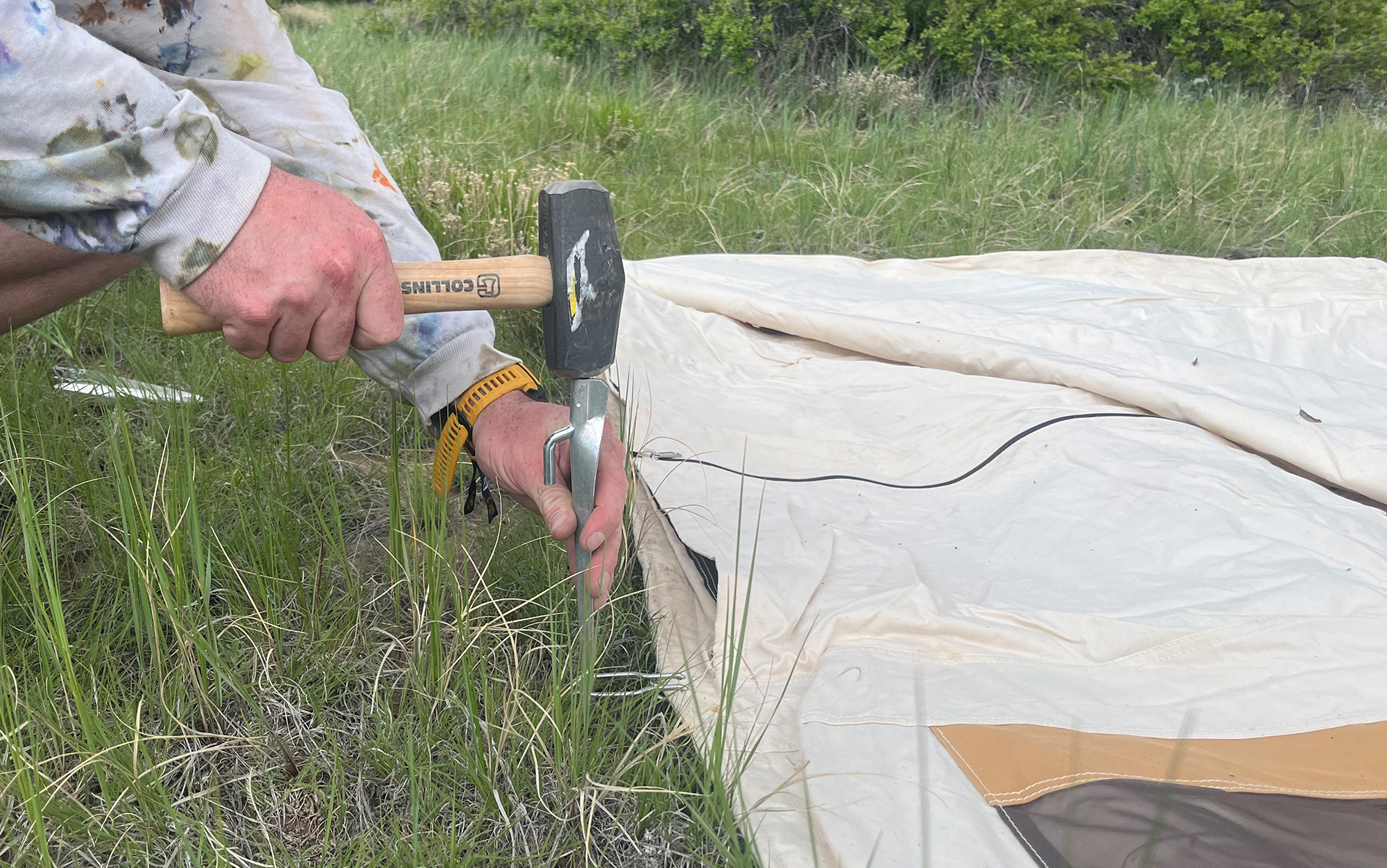
The stakes are so important because the tent is not free standing. The upright poles are tensioned and pull up on the stakes. On one desert trip, I wasn’t able to stake down the tent because the ground was too hard, so I had to improvise. While I’m sure Springbar wouldn’t recommend it, and you’re endangering the seamless vinyl floor, I successfully weighted the tent down using large rocks inside. And it was awesome. When I removed the rocks for takedown, I checked the floor and didn’t notice any tears or punctures (or any wear at all).
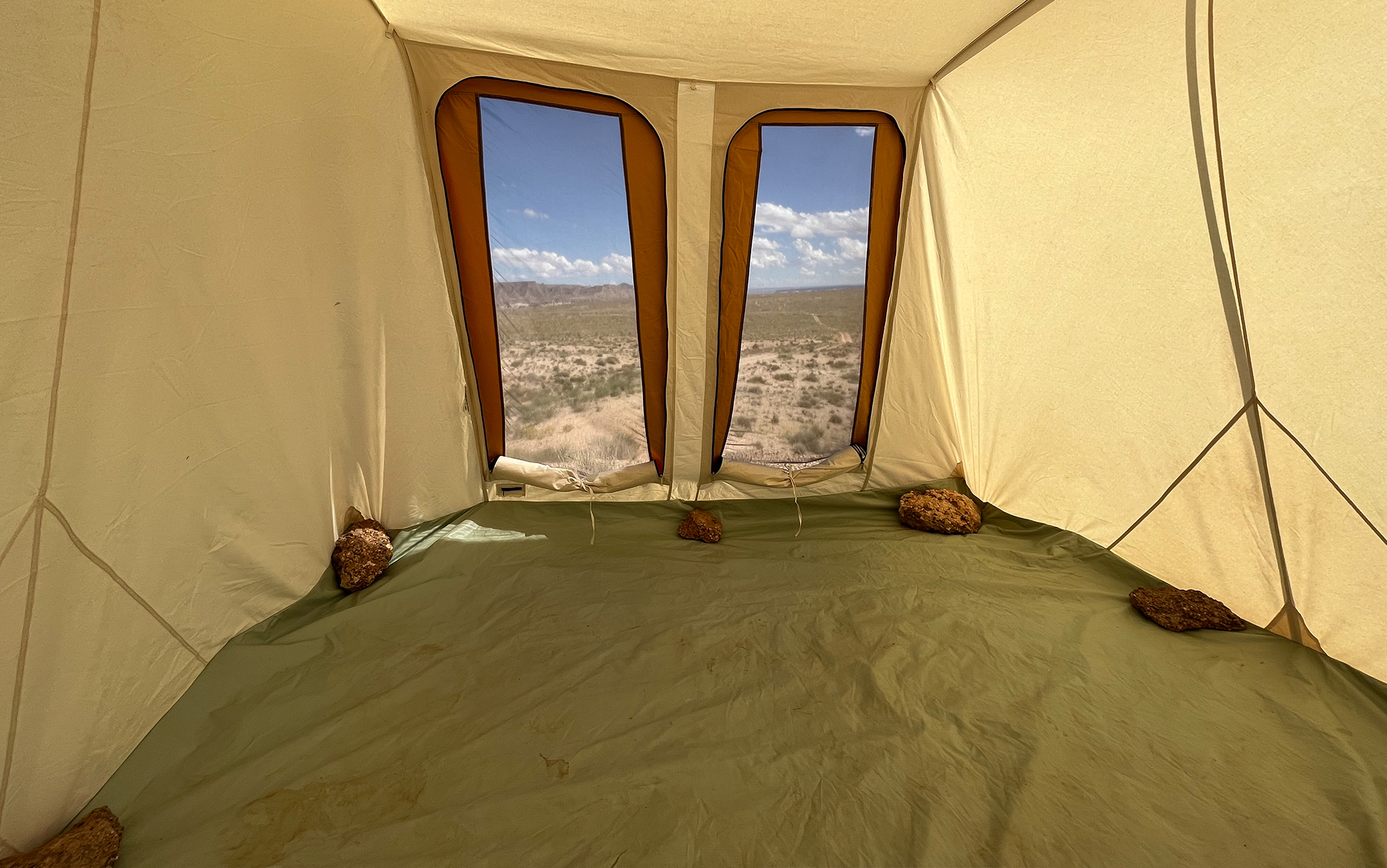
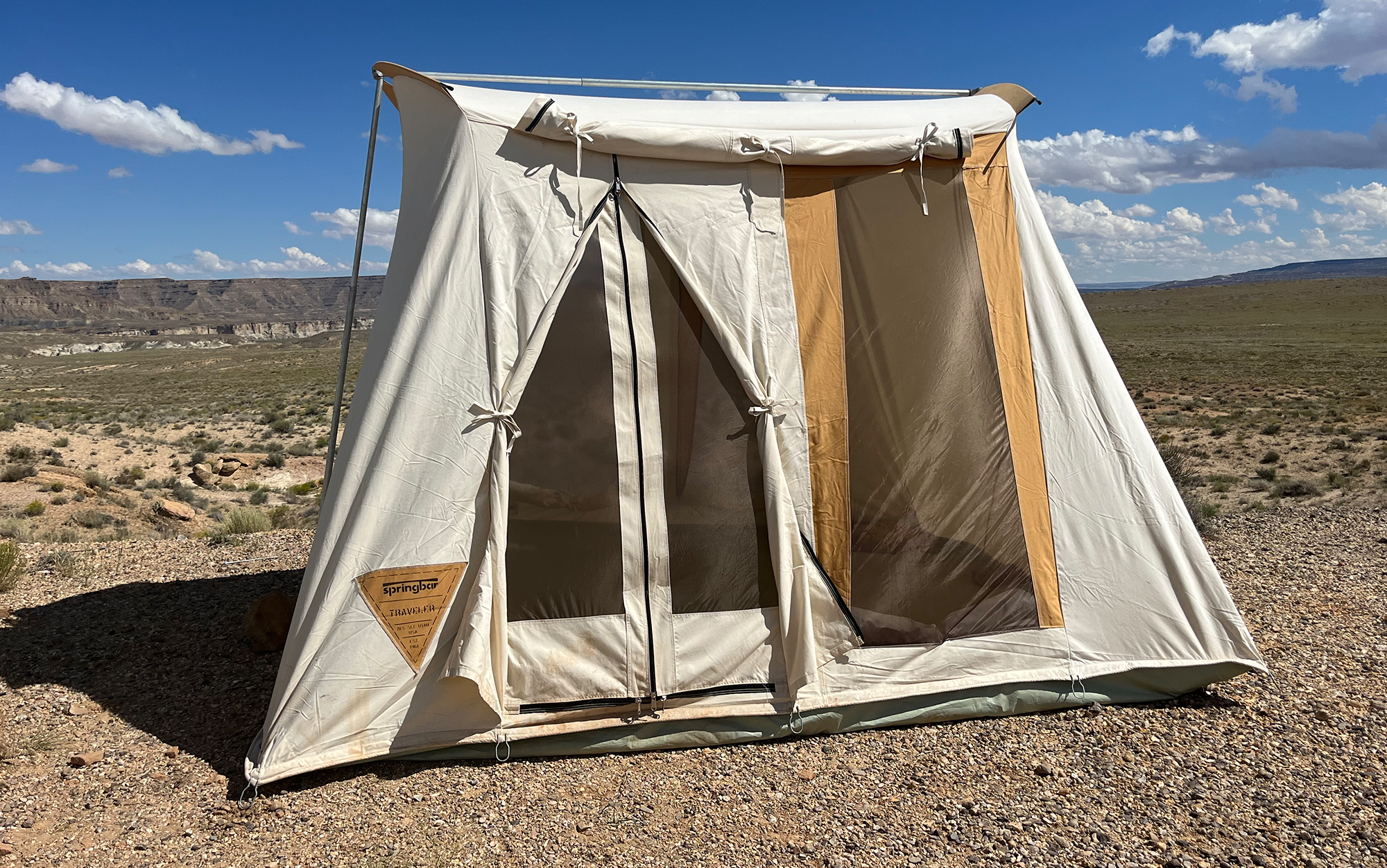
The inside of the tent is spacious and tall. I’ve spent the night in this tent comfortably with two, three, and four people. During a mid-day hail storm, six of us napped inside without issue. And I’ve spent two rainy evenings with seven people inside watching a movie we projected on the conveniently white canvas. The fact that an entire group can comfortably relax inside this tent is one of its major advantages. Whether it’s raining, buggy, or cold, there’s a cozy shelter ready to bring the group together.
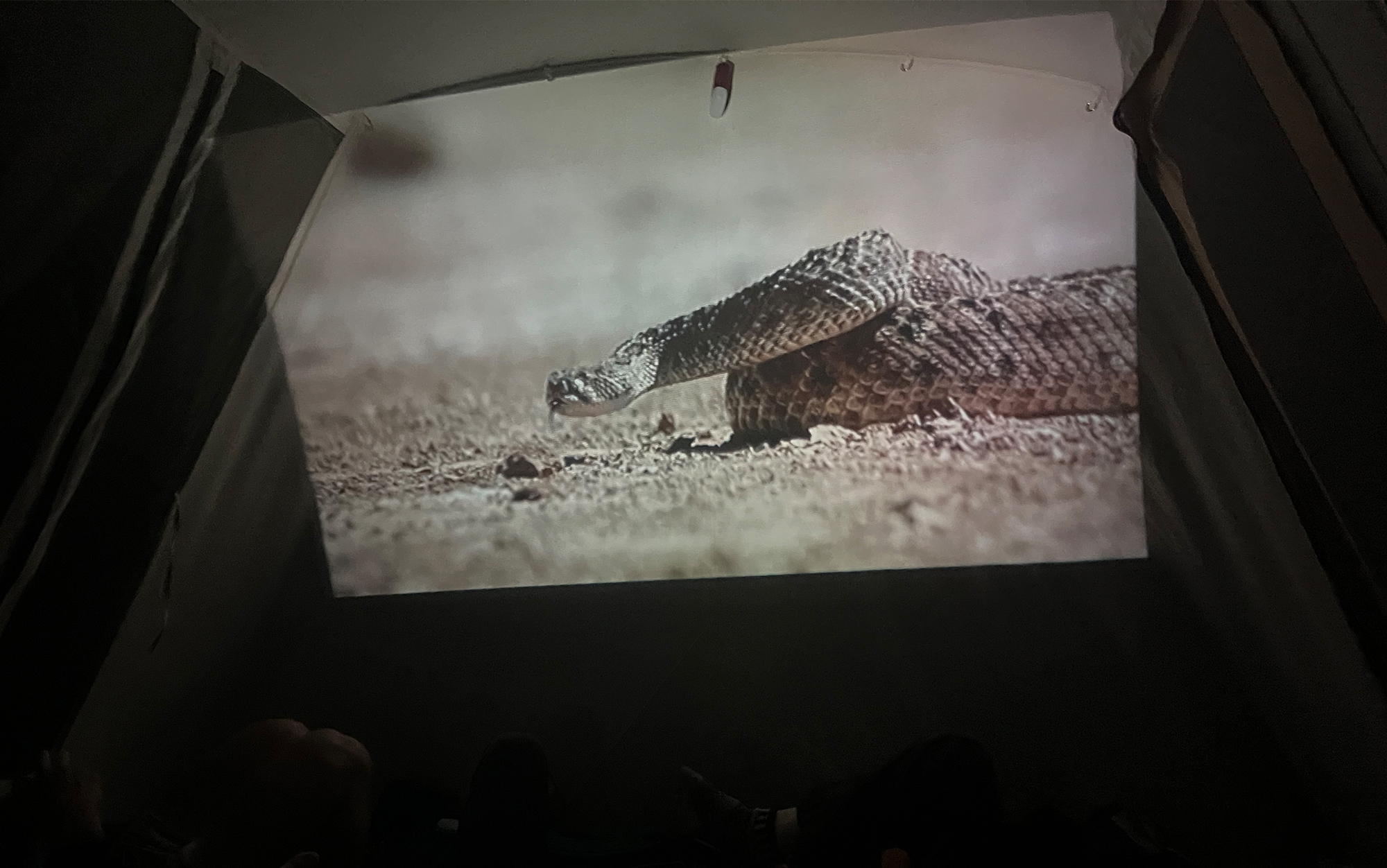
The awning is a nice touch, though sometimes it takes some trial and error to get it right. Springbar sells side panels separately that you can use to create a vestibule for even more hanging out space. During a storm, I recommend taking the awning down otherwise it can collect water. The extra shade is good for hiding a cooler. You can lower the poles to create a tiny vestibule for shoes and supplies while you’re out exploring. I love the organic rope and wooden adjusters on the awning. It’s so much more attractive and durable than plastic.
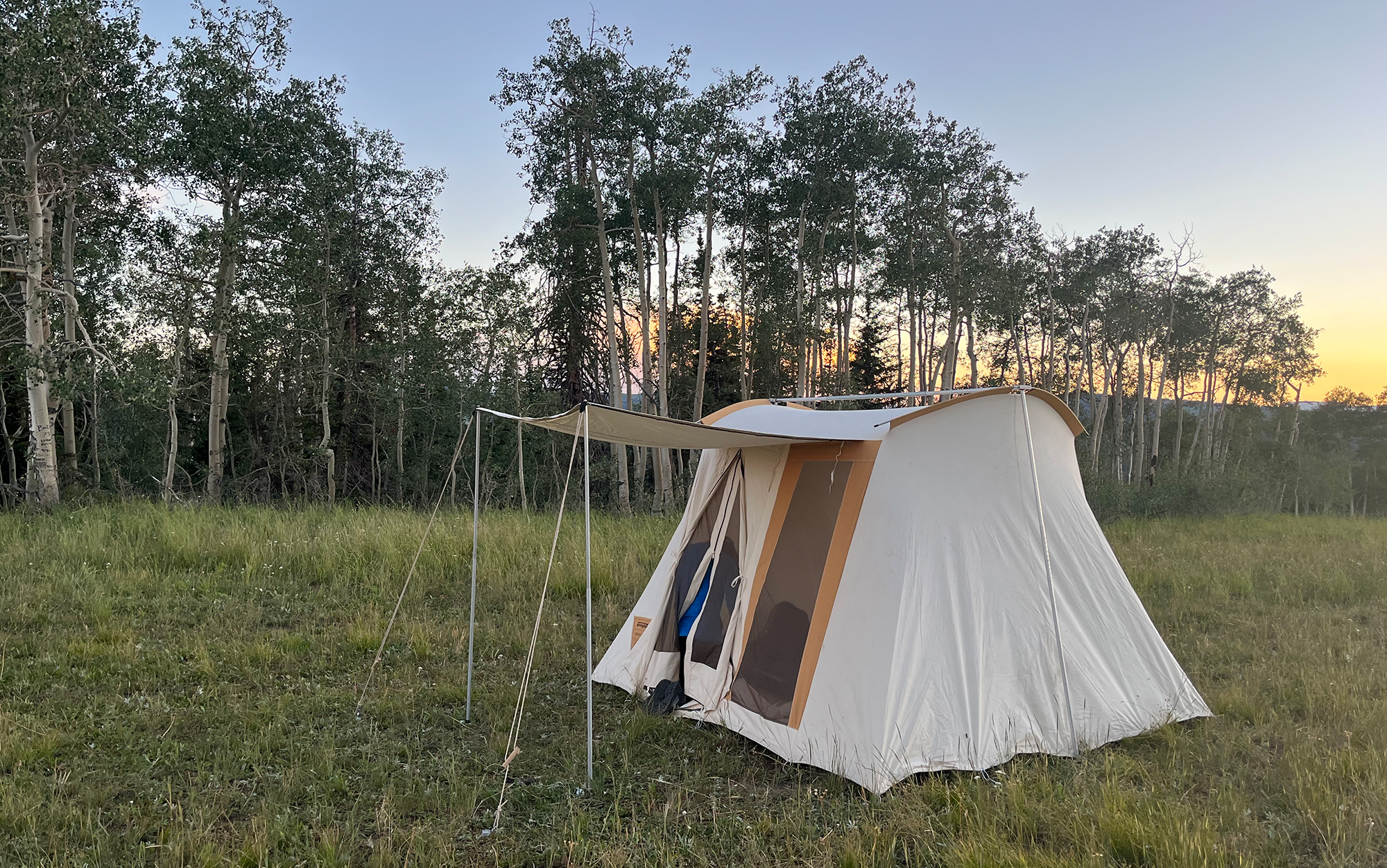
I keep a handheld broom and dustpan in the tent bag to sweep out the inside of the tent before packing it away. Simply use the back of your hammer to yank out all the stakes. The upward tension will release and the tent will collapse, allowing you to dismantle the poles. Then you fold the tent four times using the stake loops as a guide. I sweep any dirt off the bottom of the tent with the broom and use a rag if there’s any moisture before rolling it up.
After my first few trips with the Springbar, it was looking a little dirty; it is white after all. I was disappointed until a rain storm came along and left it looking good as new. With some easy maintenance and simple care instructions, I believe this tent could last me the rest of my camping days. The lifetime of a canvas tent, and its ability to be repaired, makes it more sustainable than a synthetic tent. Plus, cotton is an organic material that biodegrades, unlike nylon. The Springbar’s killer design and aesthetics makes it way more fun, too.
Springbar has a number of different canvas tent options. The size ranges are 6×8, 7×9, 8×10, 10×10, and 10×14. The models can be cut and sewn by hand in Salt Lake City, like the Traveler, or imported. The imported tents cost less, competing with other imported canvas tents, but still use the traditional Springbar design and undergo diligent testing.
If you’d like to save on a USA-made tent, you can also check out Springbar’s factory seconds page. They offer tents with only aesthetic issues for a discounted price. All of the tents are available in the following colors: pear gray, bison, natural, and suntan. Two of Springbar’s tents, the Classic Jack 140 and Skyliner, are even compatible with stoves.
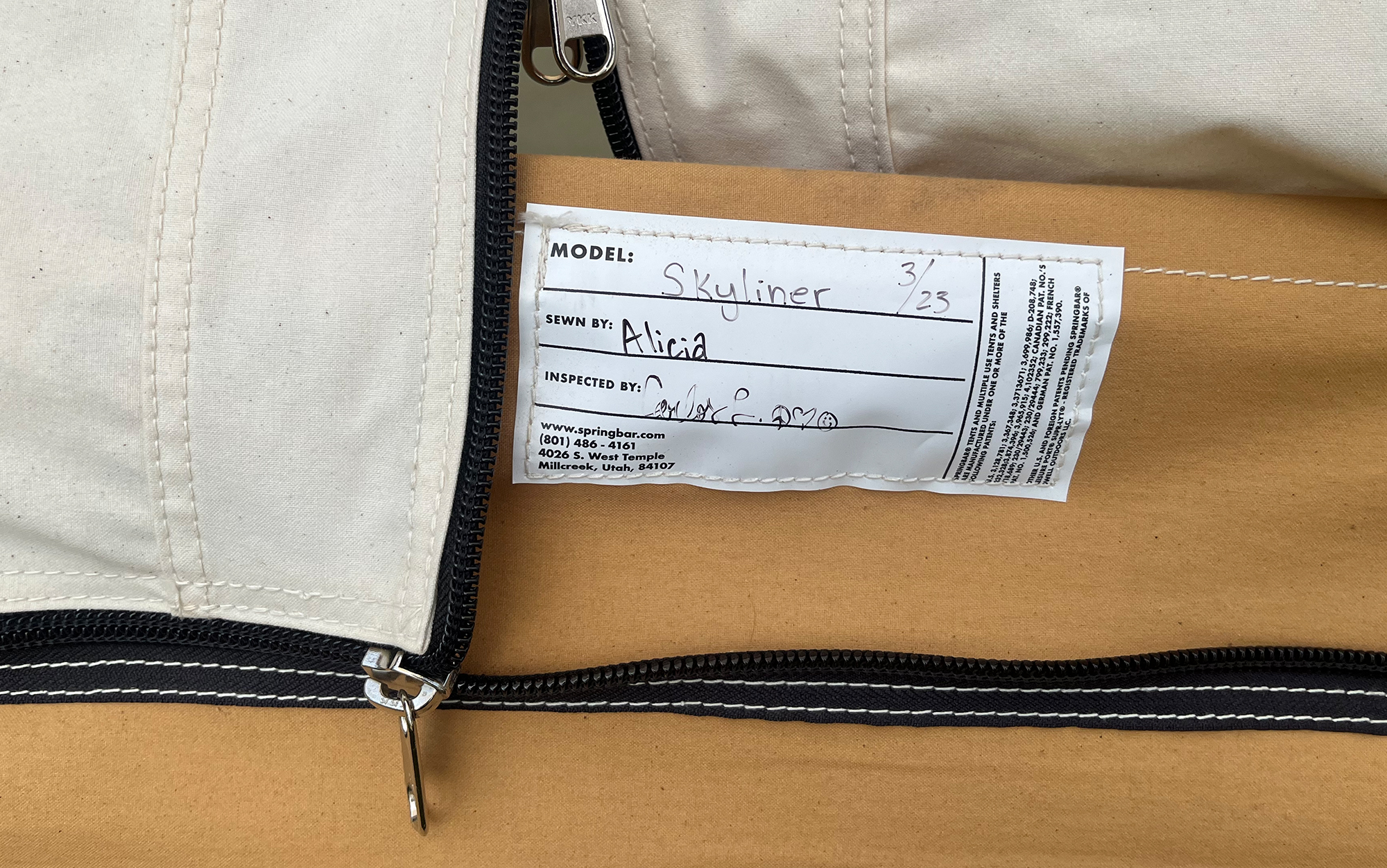
It’s a delight to get back to camp and see this home-away-from-home standing there. And it’s comfortable to hang out in, should the weather turn or you need to escape from bugs in the evening. But most of all, it gives you peace of mind. Whether you’re tucked in your sleeping bag or away from camp, there’s no doubt this tent will stay standing. My guide at the sew shop in Utah said that he had a Springbar tent up in his backyard for three years without issue. I think if you spend enough time outdoors, a reliable, durable tent like this is a sustainable investment that will bring you joy for quite literally the rest of your life.
White Duck Regatta 360 Tent
White Duck Regatta 360 Tent
Key Features
- Price: $890
- Poles: Two
- Weight: 68 pounds
- Non-freestanding
- Diameter: 13 feet
- Height: 8 feet, 2 inches
Pros
- One-person setup
- Everything included (including a stake mallet)
- Made from more sustainable, natural materials
- Great interior head height
- Easy to use guylines
Cons
- Very heavy with a large packed size
- Location of center pole limits versatility of the space
- Numerous required guylines mean you need a very large site and pliable ground
- Guyline and stake-out loops have a tendency to unravel
My initial impression of this tent was, admittedly, not enthusiastic. I knew this tent was pretty heavy, but I wasn’t prepared for how large the packed size would be. The White Duck Regatta 360 Tent comes in a duffel that’s about 4 feet long and it feels much heavier than the advertised 68 pounds. I couldn’t lift it by myself. (The packing box it came in indicated it was a two-person carry.) To get it out to the car I had to take out the poles and the stake bag and carry them separately. That’s in stark contrast to even the heaviest 8-person tents I tested, many of which weigh in at half of the White Duck.
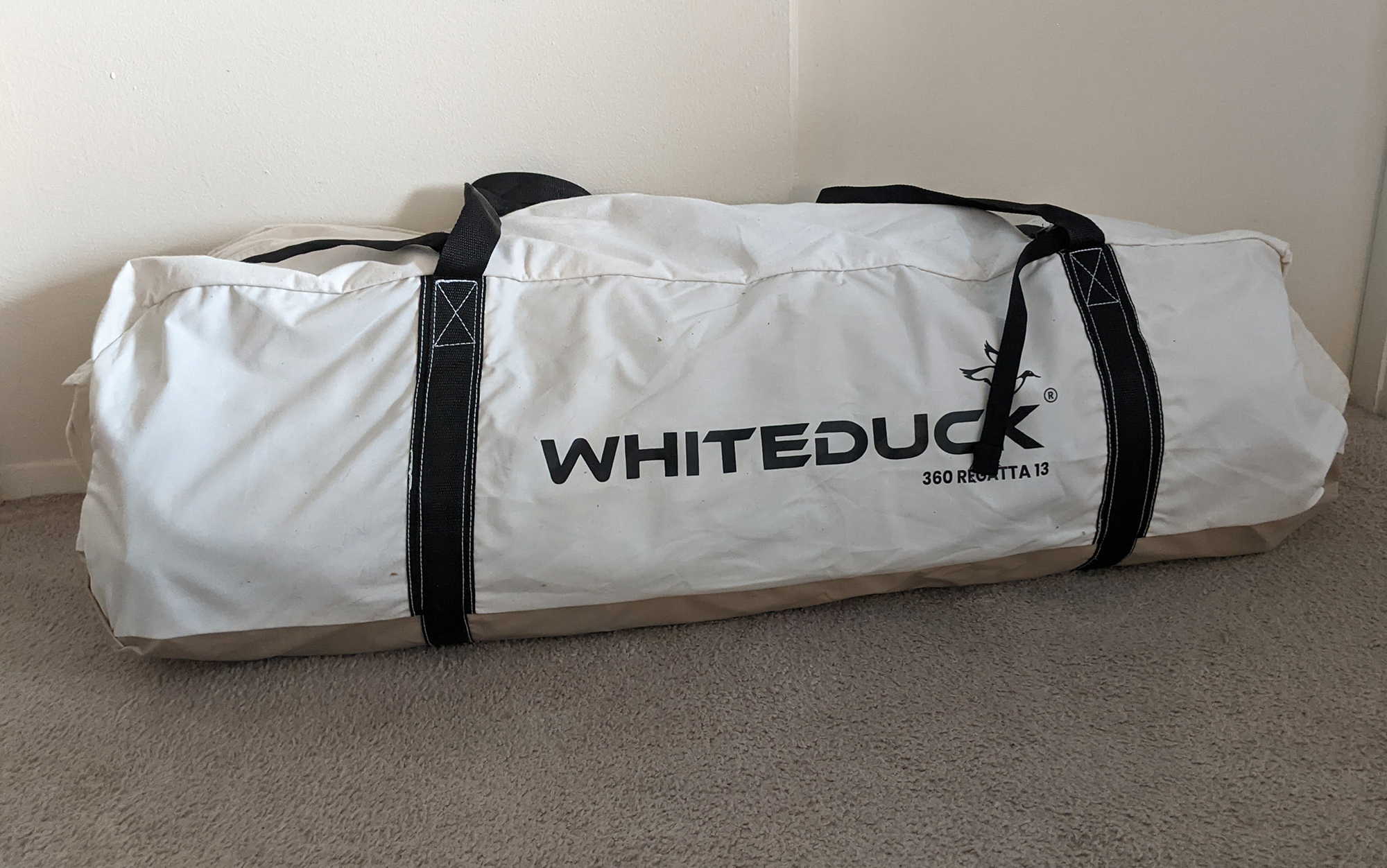
Fortunately, my initial setup of this tent was much smoother. Knowing that this would be a bit different from the typical cross-pole design of most contemporary tents, I did watch a video before attempting setup. But that was plenty of information as it really is quite straightforward, if time consuming, to erect.
The first step is to stake down the exterior, using a mallet. Then you walk into the center of the tent with the longer of the two poles and pop it into place, duplicating this effort with the shorter of the two poles at the door. Then you stake out the guylines and head around the tent slowly pulling them taut. A word the wise with this tent: It is non-freestanding, and there are over two dozen stakes that you’ll want to get into the ground to ensure the tent is secure. If you are looking at a site that is unusually rocky or otherwise impossible to properly stake into, choose a different tent.
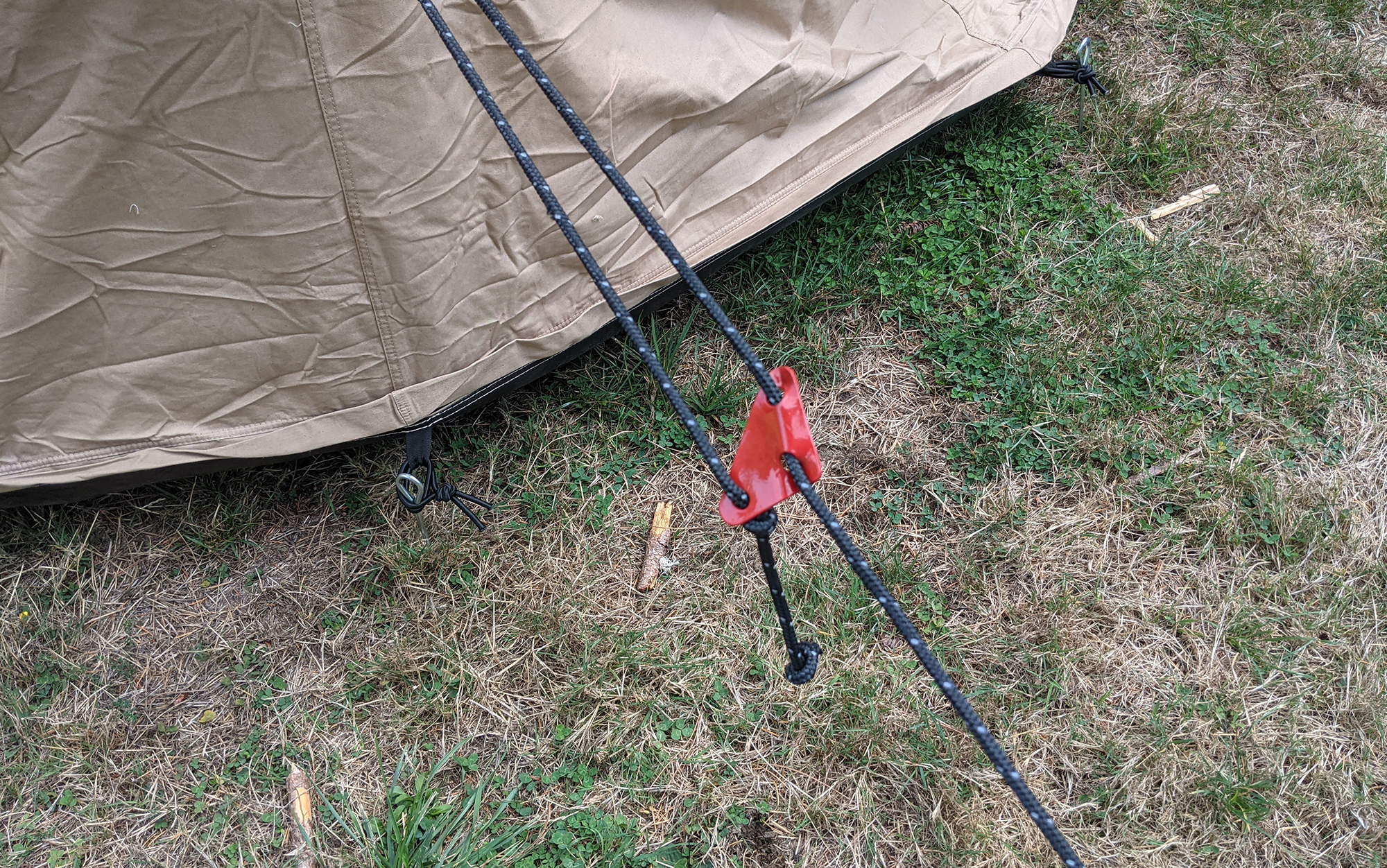
The interior space is the major selling point of this tent and it does not disappoint. I could walk around a surprising amount of this tent without ducking down, and the center pole was pushing the ceiling so far up (it goes up to 8 feet, 2 inches) that I couldn’t touch it. The three windows, as well as the mesh screens on the door, give you a lot of flexibility with how much air circulation you’re allowing versus conserving heat.
For truly hot days, you can even unzip the sides to create the titular 360-degree effect. The center pole does get in the way a bit of the usable floor space, but once the guylines are pulled taut, it is surprisingly anchored in. Most tents feel like tents on the inside; this feels more like a home. Fitting four people inside of this would be no problem, and families with multiple littles could likely get in six or more.
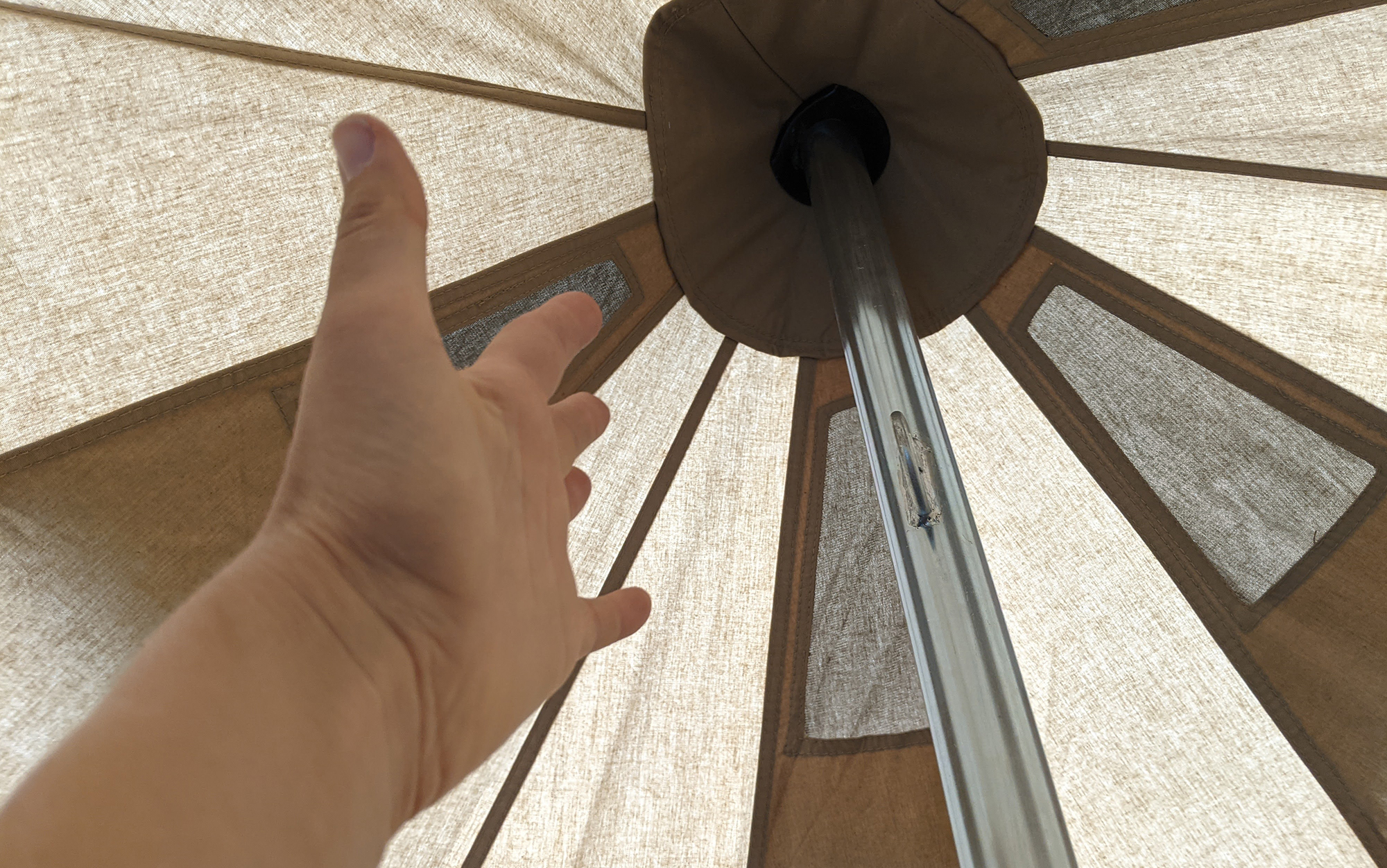
I did run into a couple of issues during setup. The first is that the center pole is somewhat difficult to align properly. There is no indication inside the tent where the center of the floor is, so you just have to eyeball where the tent pole should land. After pulling all the guylines taut, I could see that my pole wasn’t in quite the right place, but to fix it I would need to loosen all the guylines, adjust the position of the center pole, then retighten and reassess.
I wish instead there was a marker on the floor itself giving you a sense of where the center should go. I was also disappointed with the knots used to create the loops for the guylines. Two of these came undone while I was setting up the tent. While the first was easy to retie (a simple overhand knot), the second was above the door, meaning I would need to take down part of the tent to reach it and retighten.
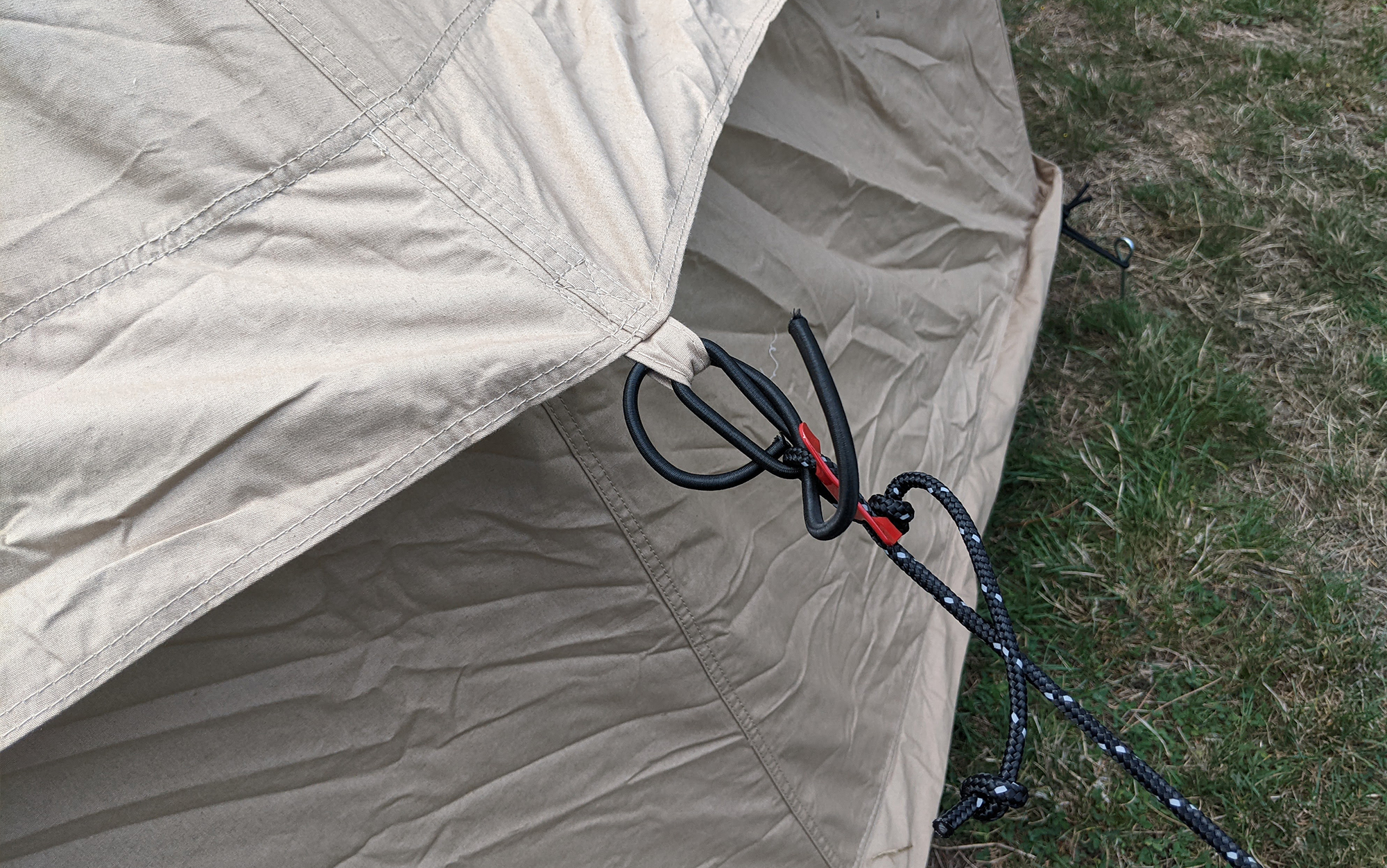
As much as I know my family would appreciate the internal space and headroom of the White Duck Regatta 360 Tent, at the end of the day its massive packed size and footprint makes it a tough choice for people looking for a more sustainable, longer-lasting alternative to traditional nylon tents. However, if you plan to set up a tent in a large open space and then leave it there for an extended period of time, this is more than worth the extra trouble and cost. The interior living space would be comfortable for a mid-sized family to spend an extended amount of time in, and it’s surprisingly easy for first-timers to get an adequate setup on the first go-round.
Things to Consider Before Buying a Canvas Tent
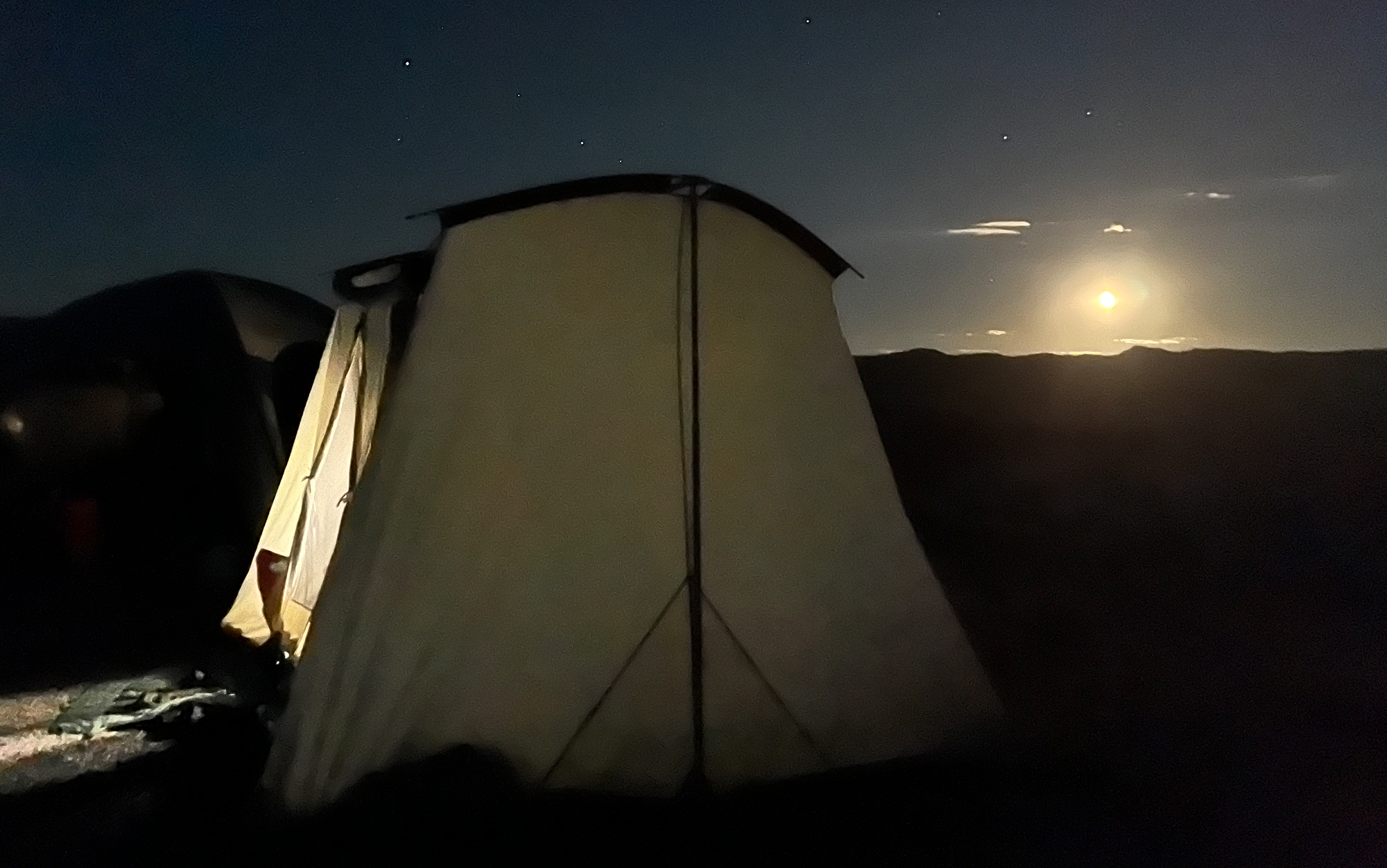
Sustainability
Canvas tents are eco conscious thanks to their natural and durable cotton material. It will take longer for these tents to reach the end of their life, and once they do, they’ll biodegrade. If you’re unhappy with the carbon footprint of your current tent, canvas tents could be your solution. Springbar’s cotton is from India but it’s weather treated in Georgia, USA; the stakes are made in Missouri, and the poles are made in Utah. Choosing locally made products is another way to recreate outdoors more sustainably.
Size
Canvas tents are bulkier and heavier than synthetics, but there’s a trade off for durability and comfort. Take into account your camping priorities, location, and storage space before committing.
Price
The cost of a Springbar Traveler is high, but the fact that it’s made in the USA is a huge advantage. While other synthetic tent brands may offer warranties and repairs, their products are absolutely being made overseas to take advantage of lower labor costs. This results in less oversight, more pollution, and longer shipping times. And it doesn’t support American labor or manufacturing. Canvas tents are also more easily and effectively repaired thanks to their thicker material.
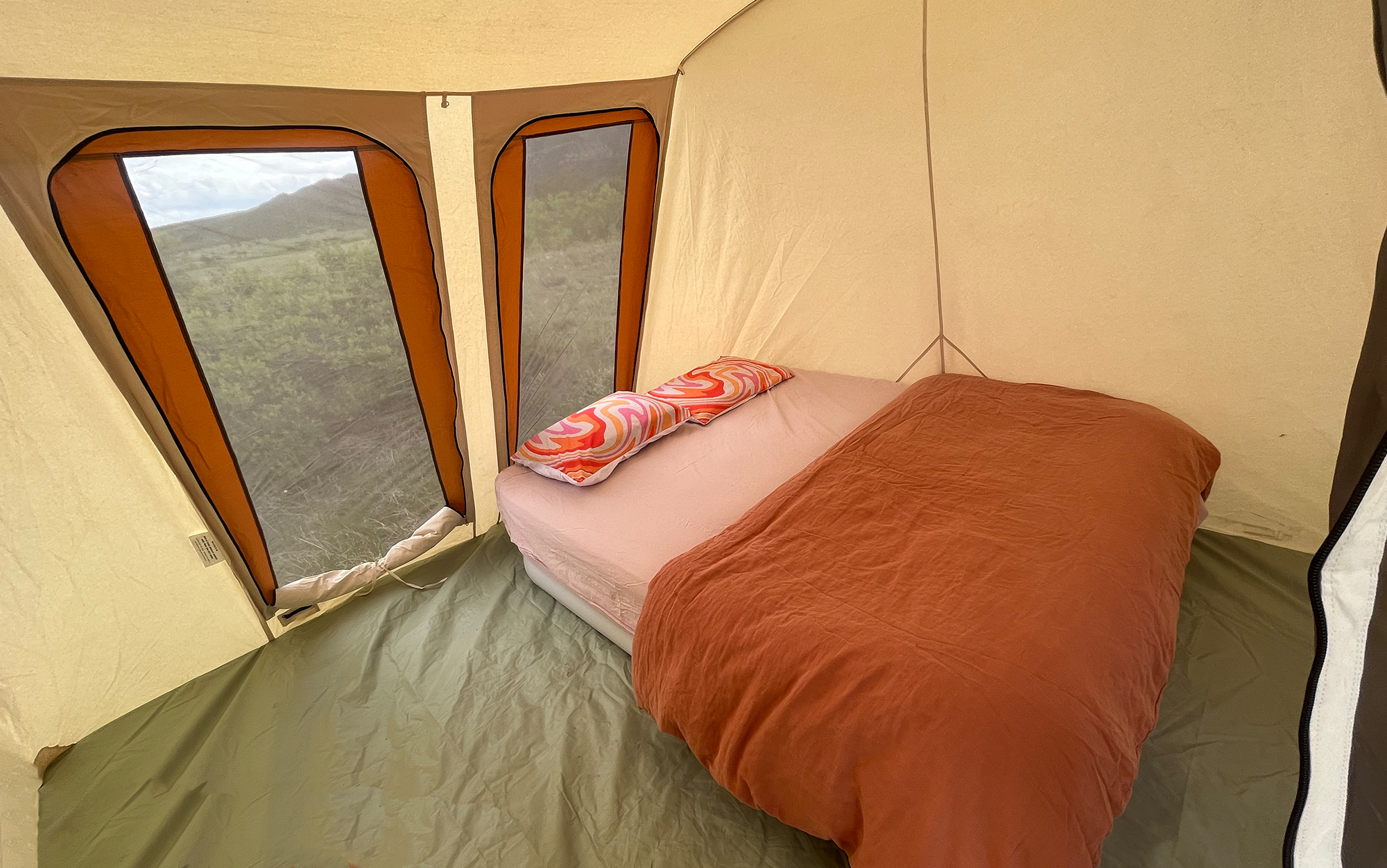
But to me, what really warrants buying a tent that’s 2.5 times more expensive than the best 6-person synthetic tent, is the comfort and aesthetics of a canvas tent. The Springbar tent feels like a home. The breathable, natural fibers are soothing and the design looks awesome. In the world of van life and Starlink, I can absolutely see this being an amazing portable home for a full-time camping lifestyle. Festival goers, hunters, and car camping families can all appreciate the appeal of an attractive and welcoming tent that holds up in any conditions.
Springbar has also clearly put a lot of work into ensuring a quality imported product that’s up to their high standards, and the legendary Springbar name. The 10×10 Highline is half the price of the Traveler and backed by the same customer service.
White Duck is also able to keep the cost of canvas tents lower, making them more accessible for campers looking to upgrade their synthetic tent (possibly after being taken out in gale force winds) to a more spacious and sustainable option.
FAQs
Yes, canvas tents are good for cold weather. Their cotton weave actually retains heat in the winter and stays cooler in the summer. Some of the best canvas tents are also compatible with stoves for winter camping.
Springbar says it’s common for customers to enjoy 30 to 40 years of good service from their tent. But if you take care of it, it’ll likely last longer. Canvas is much thicker and more durable than other materials and it can withstand more longer-lasting repairs than synthetic tents.
Cotton is the most breathable material for canvas tents. While you can add synthetic fibers to create waterproofing, you start to lose the magic of a tent that breathes with the seasons while protecting you from moisture and sun rays.
Final Thoughts on the Best Canvas Tents
I think it’s fair to say that canvas tents certainly still have a place in the modern weekend warrior’s gear quiver. If you’re willing to spend the extra time and energy to assemble a more durable and sustainable tent, you’ll be rewarded with more space, comfort, and peace of mind. We tested two of the most popular canvas tents available in an already small market to give you an idea if the best canvas tents could be the right choice for you.
